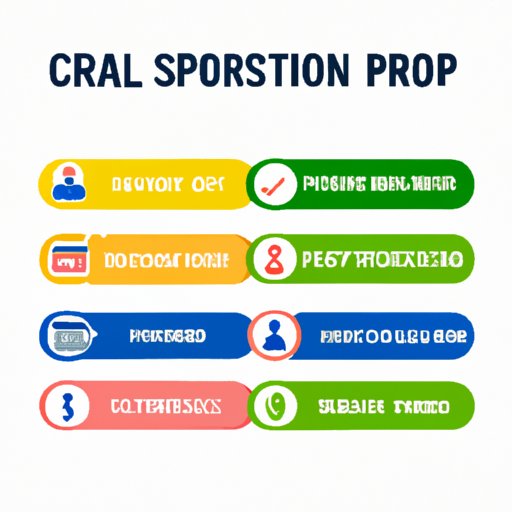
I. Introduction: The importance of understanding the personal loan process
Getting a personal loan is a big financial decision that requires research, preparation, and attention to details. Whether you want to consolidate debt, finance a major purchase, or pay for unexpected expenses, understanding the personal loan process is crucial to getting the best deal and avoiding pitfalls. This guide is designed to provide a step-by-step approach to getting a personal loan, help you understand the types of loans available, provide tips for improving your chances of getting approved, and highlight common mistakes to avoid. This guide is for anyone who is new to personal loans and wants to make an informed decision based on their needs and circumstances.
II. Step-by-step guide to getting a personal loan
Before you apply for a personal loan, there are several steps you need to follow to ensure that you get the best deal possible. Here’s a step-by-step guide to getting a personal loan:
1. Research lenders:
The first step in getting a personal loan is to research lenders. You can start by using an online search engine to find lenders that offer personal loans. Look for reputable lenders with a proven track record of providing quality service to their customers. Be sure to read reviews from other borrowers to get an idea of what to expect from each lender. Compare offers from different lenders to find the best interest rates, fees, and repayment terms that fit your needs.
2. Pre-qualify:
Before you submit an application for a personal loan, it’s a good idea to pre-qualify. Pre-qualifying means that you can check your credit score, estimate your loan amount, and get an idea of what interest rate you can qualify for before you apply. You can check your credit score and report for free using online services like Credit Karma or AnnualCreditReport.com. Keep in mind that pre-qualification does not guarantee approval for a loan, but it can give you a better idea of what to expect.
3. Submit an application:
If you decide to apply for a personal loan, you will need to submit an application to the lender of your choice. The application process typically requires you to provide personal information, employment information, and financial information. You may also need to provide proof of income, such as pay stubs or tax returns. Be sure to fill out the application completely and accurately to avoid delays or rejections.
4. Get approved:
If you are approved for a personal loan, the lender will provide you with an offer that outlines the terms and conditions of the loan. Be sure to review the offer carefully, including the interest rate, fees, and repayment terms. If you have any questions or concerns, don’t hesitate to ask the lender for clarification. If you are satisfied with the terms, you can accept the offer and sign the loan agreement.
III. Understanding the types of personal loans available
There are two main types of personal loans available: secured and unsecured loans. Let’s explore the differences between these two types of loans.
1. Secured vs. unsecured loans:
Secured loans require you to provide collateral, such as your car or home, to secure the loan. The collateral serves as a guarantee that you will repay the loan. If you fail to make payments on the loan, the lender can repossess the collateral to recover their losses. Unsecured loans, on the other hand, do not require collateral. Instead, the lender relies on your creditworthiness and income to determine your eligibility for the loan. Unsecured loans typically have higher interest rates than secured loans because they are considered higher risk.
2. Installment loans vs. revolving credit:
Another factor to consider when choosing a personal loan is whether the loan is an installment loan or a revolving credit line. Installment loans are fixed-term loans that require you to repay the loan in fixed monthly installments over a set period of time. Revolving credit lines, such as credit cards, allow you to borrow money up to a certain limit and pay it back over time, with interest. Installment loans can be a good choice if you need a specific amount of money for a specific purpose, while revolving credit can be more flexible and convenient for ongoing expenses.
IV. Tips for improving your chances of getting approved for a personal loan
If you want to improve your chances of getting approved for a personal loan, there are several things you can do:
1. Improve your credit score:
Your credit score plays a crucial role in determining your eligibility for a personal loan. Lenders use your credit score to assess your creditworthiness and determine your interest rate and loan amount. To improve your credit score, make sure you pay your bills on time, keep your credit card balances low, and dispute any errors on your credit report.
2. Show a stable income:
Lenders want to know that you have a stable source of income to repay the loan. They will look at your employment history, income level, and debt-to-income ratio to assess your ability to repay the loan. To improve your chances of approval, make sure you have a steady job and a good income stream.
3. Provide additional collateral:
If you don’t have excellent credit or a stable income, you can still improve your chances of approval by providing additional collateral. Collateral can include assets like your car, home, or investments. Be aware that if you fail to repay the loan, the lender can repossess your collateral.
V. Common mistakes to avoid when taking out a personal loan
When taking out a personal loan, there are several common mistakes to avoid:
1. Borrowing more than you can afford:
Before taking out a personal loan, make sure you can afford the monthly payments. Calculate your total debt-to-income ratio, including all of your monthly bills, to determine how much you can afford to repay each month. Don’t borrow more than you can afford, or you may risk defaulting on the loan.
2. Ignoring the fine print:
Make sure you read the terms and conditions of the loan carefully before signing the agreement. Look for hidden fees, penalties, and other charges that may apply. Understand your rights and protections as a borrower, including the right to dispute errors and report fraud.
3. Using the loan for the wrong purpose:
Personal loans are intended for specific purposes, such as debt consolidation, home improvements, or medical expenses. Don’t use a personal loan for non-essential purposes, such as vacations or luxury items. You may end up paying more in interest than the value of the item or experience you purchased.

VI. The pros and cons of getting a personal loan
There are both pros and cons to taking out a personal loan. Here’s a closer look:
1. Pros:
Personal loans can be a great way to consolidate debt, finance a major purchase, or pay for unexpected expenses. They are typically easier to qualify for than other types of loans, and they can have lower interest rates than credit cards or payday loans. They can also help you build your credit score if you make timely payments.
2. Cons:
Personal loans can come with risks and drawbacks, such as high interest rates, fees, and penalties. If you fail to make payments on the loan, you may damage your credit score and risk losing any collateral you provided. You may also end up paying more in interest and fees than the original amount of the loan.
VII. Additional resources for getting a personal loan
Here are some recommended resources for getting a personal loan:
- Bankrate.com: Offers a comprehensive database of lenders and loan offers, as well as tools and calculators for estimating your loan amount and interest rate.
- AnnualCreditReport.com: Provides free access to your credit report from the three major credit bureaus, so you can check for errors and discrepancies.
- Mint.com: Helps you manage your personal finances, including budgeting, bill tracking, and credit monitoring.
VIII. Conclusion: Recap of key points and call to action
To wrap it up, getting a personal loan requires research, preparation, and attention to details. Follow these steps to increase your chances of getting approved:
- Research lenders
- Pre-qualify
- Submit an application
- Get approved
Remember to compare offers, understand the types of loans available, and look for ways to improve your credit score and income. Avoid common mistakes, such as borrowing more than you can afford or ignoring the fine print. Consider the pros and cons of getting a personal loan, and make an informed decision based on your needs and circumstances.





